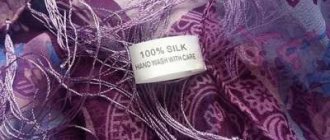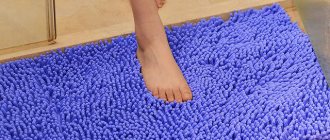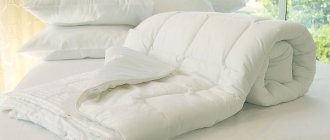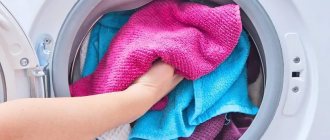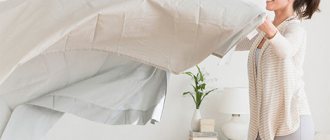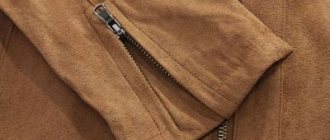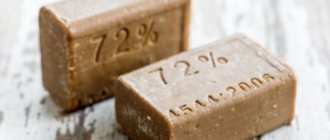Sleeping under an incredibly soft and weightless silk blanket is a great pleasure. But during use, stains may appear on your favorite bedding or they will simply lose their original appearance. In this case, you should carefully study the question of how to wash a silk blanket so as not to spoil it.
Types and features of silk blankets
The peculiarity of natural fiber used as filler is its resistance to clumping. A blanket with natural silk is created by hand, laying layers of insulation perpendicular to each other. Then it is sewn to the silk cover without quilting. For filling, long-fiber varieties of silkworm are used. The layers are a homogeneous mass of good strength.
Winter, summer, all-season
They produce several varieties of blankets, which differ in their warming ability, it depends on the number of layers and the fabric of the cover. Summer with a density of 120 to 190 g/m2 is used instead of a terry sheet or duvet cover at an air temperature of 24C°. All-season with a density index of 200...300 is suitable for winter in well-heated rooms. The winter option is a good alternative to wool, cotton or padding polyester analogues, lighter than a duvet. The filling density reaches 400 g/m2, such a sleeping item will warm you when the room is only +17C°.
Types of silk filler
Before choosing a silk product, you should carefully study the label. Some companies prefer wild silkworm threads, most prefer domesticated ones; the insects are specially bred and raised in captivity using a certain technology, when there are two larvae in the cocoon at once. Each fiber has its own pros and cons:
- Tussa made from wild silkworm larvae is subjected to bleaching, which negatively affects the quality of the raw material.
- Mulberry is artificially grown and retains the natural properties of the thread.
Note! Products marked AA grade are usually more expensive than A grade. Details below.
On silk blankets, stitching is often used for decorative rather than practical purposes. The fiber does not tangle during use.
Percentage of silk in filler
Silk blankets are made not only with silk, but also with mixed filling. Add to natural silkworm fiber:
- down of birds and animals (undercoat);
- long-fiber wool;
- bamboo;
- synthetics (mostly polyester).
On the labels you can see the following compositions with silk content from 100 to 30%.
For reference. The price of a blanket depends on what material and in what quantity is added to the silk base.
Case materials
According to the technology for producing blankets with silkworm thread, a cover is provided. Natural fabrics are used for these purposes:
- Silk in silk is the most luxurious option, with good aesthetic and performance characteristics. Such products are more suitable for summer, pleasant to the touch, and absorb moisture well.
- Batiste is a light, thin cotton fabric, not inferior in density to silk, but more pleasant and warmer. Recommended for people with sensitive skin, often used when sewing baby blankets.
- Satin comes in two types: regular and jacquard, characterized by high strength and durability. Smooth fabric with shine can be washed often, but over time it fades and becomes fleecy.
- Teak is a dense fabric with an anti-feather effect used for mixed fillers. The main disadvantage is the shallow scar, which is tactilely felt by sensitive people.
On a note . The best option would be a satin case. The fabric fits comfortably into a duvet cover, absorbs sweat well, and is pleasant to the body.
Hand washing methods
A silk, down, bamboo, cotton or wool blanket should be washed in a washing machine only in exceptional cases when it is not possible to remove dirt by other means. For such species, it is best to use the manual method.
Silk
Before washing, you need to remove the filling from a silk product, soak it in a warm soapy solution for 1-2 hours, rinse thoroughly, dry it, and return the silk filling fibers to the blanket cover.
Sheep and camel
Items made from sheep, camel, and other natural wool, as well as items made from bamboo, should be soaked in a bathtub (temperature should be at 30°C), in a straightened position; for this purpose, it is best to use special detergents for washing woolen or cotton items.
Cotton
A cotton blanket must be completely immersed in a foam solution (temperature no more than 40°C) for 20–30 minutes, rinsed several times, rolled into a tight roll (to remove as much water as possible);
All blankets with natural fillings should not be wrinkled, rubbed or twisted during the washing process. You just need to put them in water and take them out, then rinse them several times until the detergent is completely removed, and let them drain.
Dry them only on a horizontal surface, preferably in the open air, after thoroughly spreading out the contents in an even, homogeneous layer, without lumps or thickening.
Products made from delicate or natural materials tolerate dry cleaning best. In this case, the product is not completely immersed in water, but only thoroughly cleaned the contaminated areas with a foam solution and a clean sponge. To do this you need:
- thoroughly clean the blanket from dust with a vacuum cleaner;
- lay the blanket evenly on a horizontal surface that is suitable in size for the product;
- dilute a special concentrated detergent with warm water, beat until thick foam;
- Using a clean sponge, apply foam evenly to the surface of the product, do not rub, but remove dirt with gentle movements;
- Rinse with clean cool water and dry in a horizontal position.
Silk varieties
Sometimes users, looking at silk products in stores, are perplexed why a viewing screen for blankets and pillows made from silkworm threads was invented. The answer is simple: the pocket is needed to ensure the quality of the filler used. Depending on the grade of silk, the cost of finished products is determined. For the “filling” use:
- Waste of raw silk obtained during the rejection process when unwinding the cocoon. Low-grade filler looks like cotton wool, the fibers are short, do not stretch, but remain in the hands, and have a milky tint.
- Mulberry short-fiber mulberry silk is prone to bunching; the products are additionally stitched to hold the fibers together. The more seams, the worse the quality of the raw materials used.
- Wild Tussah silk is not uniform in shade, this is due to the fact that the silkworm feeds not only on mulberry leaves, but also on other tree species. Filler of average purity level, with average consumer properties .
- Class A Mulberry contains clumps of fibers and has a characteristic pearl luster. This variety is most often used in the mass production of blankets and pillows.
- Mulberry class AA is high-quality silk, these are long fibers from intact cocoons, of a high degree of purity, used to produce luxury products.
What to do if there are problems - if the filling has rolled up, the blanket has become hard, or an odor has appeared
After improper washing and drying, you can encounter many unpleasant consequences. It is necessary to rewash the product only as a last resort, if the methods from the list below did not help.
How to clean a mattress on a bed at home - secrets of advanced housewives
Here are some common problems and how to solve them:
- Lumps have formed . If simple kneading and shaking does not help, use a vacuum cleaner. You can also try beating with a carpet beating tool.
- Unpleasant smell . To eliminate it, let the product lie outside for some time. Ideal if the weather is windy.
- The material has become hard . In this case, you will have to wash it, but this time be sure to use a good fabric softener.
Most duvet fillers can easily be washed in an automatic machine if done correctly and not too often. For surface stains, it is better to use dry cleaning, so the blanket will last longer.
Don't forget that drying is as important a part of the process as washing itself. A poorly dried product will have to be washed again.
Colors
Manufacturers offer silkworm blankets in various colors. Fillers come in white or cream shades. If the caterpillar feeds on oak leaves, it is dark gray. Mulberries produce white or yellowish threads that do not require chemical bleaches. High-quality varieties have a pearlescent sheen.
Note! Usually, expensive Mulberry AA class products are trimmed with gold edging.
Periodicity
You need to wash the blanket as it gets dirty. If the stains are minor, then it is enough to limit yourself to local cleaning.
General recommendations for washing frequency:
- wool products – once every 6 months;
- synthetic and cotton blankets – once a year;
- down products – once every 4-6 months.
The duvet cover needs to be treated at least once every 7-10 days. Otherwise, the blanket itself will quickly get dirty. You need to knock dust out of it once a week, every time you change the cover.
How to determine authenticity
To choose a silk blanket of a decent level, you should carefully examine and feel the textile product. Must not be:
- rough stitches, silk is fastened pointwise;
- Leading companies sew a piping along the edge of the blanket - a kind of brand sign;
- lumps, only low-grade silk can mat.
In the inspection pocket you can check the color, naturalness and length of the fiber. The blanket should fluff up quickly and weigh little.
Important! There are many counterfeit products on the market that look like branded products. You need to ask sellers for certificates.
What do the icons on the tag mean?
Each product comes with a label with basic washing instructions. It shows international symbols for washing, ironing and drying conditions. Usually there are 5 or 6 of them:
- what type of washing is allowed (prohibited), recommended water temperature;
- Is it possible to use detergents containing bleach?
- dry cleaning is allowed (with a solvent other than trichlorethylene, gentle, with mild solvents), prohibited;
- Spin is allowed (prohibited);
- type of drying (unfolded, dry vertically, stretched);
- allowed (prohibited) to iron, recommended temperature.
How to care
Any things get dirty over time. For most models, manufacturers only allow dry cleaning. It is not advisable to use washing powders with PVA.
If you need to refresh textiles, it is better to wash them by hand using soap and conditioner. Only large contaminants are removed in machines using a delicate mode. Dry silk in the shade. Stains are often removed with ethyl alcohol, then wiped with a damp cloth.
A high-quality silkworm blanket can be machine washed. The main thing is to distribute the product evenly over the walls.
Entrust the item to professionals
The best solution is to take your silk blanket to the dry cleaner. Specialists will remove dirt using the dry method and refresh the product. With the help of careful processing, professionals will return the bedspread to its original appearance.
If you have never used dry cleaning services, we will tell you how the process works. The blanket should be brought to the collection point or handed over to the courier. The technologist will carefully examine the product, examine the contamination, determine the type of stains, tell you about the chosen method of processing silk, and announce the cost of the work.
Pros and cons of silk blankets
The products are soft and light, the fiber is a good thermostat, does not create the effect of overheating, and maintains natural body temperature. Hypoallergenic fiber is not electrified and is not of interest to insects.
Blankets with silk filling also have disadvantages: high cost and difficulty of care.
For reference. Silk can absorb moisture up to 30% of its volume.
High-quality silk blankets have a beneficial effect on the body, provide comfortable rest and restful sleep. The main thing is to choose the right product, taking into account seasonality and the air temperature in the apartment or house.
General washing tips
How to wash a blanket correctly:
- read the information on the label;
- inspect the product for holes, sew it up if necessary (otherwise the filler will come out);
- Roll it up before washing to make it easier to put inside;
- choose a detergent suitable for this type of product.
Choosing a detergent
These products are suitable for washing blankets:
- Nordland sportswear cleaning balm – suitable for down clothes;
- gel Laska wool and silk – for wool products;
- Burti Wollpflege liquid – for delicate washing.
This is interesting: How to remove a greasy stain on clothes: at home, after washing, recommendations for choosing a product for fresh, old stains
Prices: summary comparison table
| Blanket name | Characteristics | price, rub. | ||||
| Type | Size | Filler | Case material | Density/weight | ||
| Asabella in satin case | warm | 170 × 205 cm | natural silk | jacquard luxury satin, 100% cotton | Product weight: 1840 g, filler weight: 900 g | 11 702 |
| OnSilk Comfort Premium | lung | 140 × 205 cm | Mulberry silk 100% | satin jacquard, 100% cotton | 160 g/m² | 12 450 |
| Dargez Monteriya | lung | 172 × 205 cm | silk 100% | satin 100% | Weight: 1880 g | 6 587 |
| German Grass Fly Silk Grass | lung | 150 × 200 cm | Mulberry silk 100% | jacquard satin – cotton 80%, TENCEL 20%, jacquard satin | 170 g/m² | 26 150 |
| Togas Selena | all-season | 155 × 215 cm | Tussa silk 100% | cotton jacquard | 350 g/m² | 23 758 |
